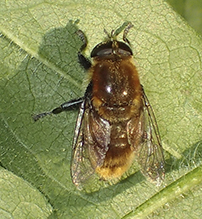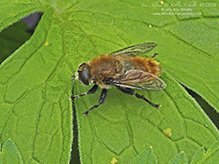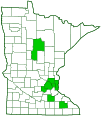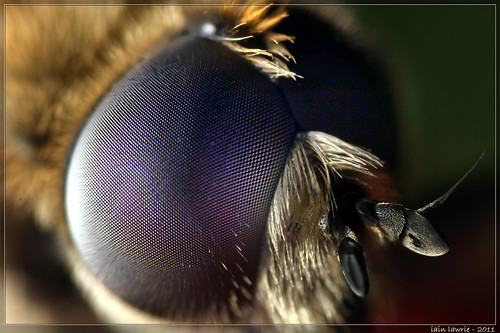narcissus bulb fly
(Merodon equestris)
Conservation • Description • Habitat • Ecology • Distribution • Taxonomy
Conservation Status |
|
|||||||
| IUCN Red List | LC - Least Concern |
|||||||
| NatureServe | NNA - Not applicable |
|||||||
| Minnesota | not listed |
|||||||
Description |
||
Narcissus bulb fly is a large, exotic, hover fly. It strongly resembles a small bumble bee. It is native to Europe. It has been introduced into Great Britain, Japan, New Zealand, and North America. It spreads when bulbs from Europe are shipped worldwide. In North America it is adventive, not naturalized – its numbers cannot be sustained without periodic population boosts from Europe. In the United States it occurs in the east from Maine to Georgia, west to Minnesota and Illinois, and west of the Rocky Mountains from Washington to central California. Between these regions it also occurs in the areas surrounding the largest cities. Larvae feed on the bulbs of Narcissus and other plants in the Lily (Liliaceae) family. They are considered serious pests of daffodils. Adults fly low to the ground among vegetation and are seldom seen. They feed on pollen and nectar of a wide variety of flowers. Adults are robust, hairy, and ½″ to ⅝″ (12.3 to 17.2 mm) in length. Several subspecies have been described on the basis of the color of the hairs on various parts of the body. These are now treated as color morphs of a single variable species. The head is hemispherical, not flattened. There are two large compound eyes on the sides of the head and three small simple eyes (ocelli) in a triangle on the top of the head (vertex). The compound eyes are covered with short erect hairs. On the male they are narrowed abruptly and meet at the top of the face (frons). They do not meet on the vertex in either sex. The difference is visible when viewed from the front but not from the rear. The face is mostly covered with hairs. The antennae are short and black. They have three segments. At the base of the third segment (flagellum) there is a long, forward-pointing bristle (arista) on the upper side. The thorax and abdomen are densely covered with erect yellow, orange, and black hairs. On one morph the hairs are entirely yellow. One morph has a broad, sharply defined, black band at the rear of the thorax extending onto the front of the abdomen. More commonly, the thorax and abdomen have orange, yellow, and black hairs, but the extent of the black and orange hairs is highly variable. The intensity of the orange hairs is also variable, from dark burnt orange to bright orange to orangish-yellow. At the tip of the wing the end of the M1 vein curves inward toward the wing base, creating a cell that is said to resemble a sock. The legs are entirely black. On the hind legs of the male there are two spurs at the tip of the fourth leg segment (tibia). |
||
Size |
||
½″ to ⅝″ (12.3 to 17.2 mm) |
||
Similar Species |
||
Habitat and Hosts |
||
Narcissus and other plants in the Lily (Liliaceae) family |
||
Ecology |
||
Season |
||
Mid-March to late July |
||
Behavior |
||
Adults fly low to the ground |
||
Life Cycle |
||
Maggots overwinter |
||
Larva Food |
||
|
||
Adult Food |
||
Pollen and nectar of a wide variety of flowers |
||
Distribution |
||||
|
Sources |
|||
| 11/27/2022 | ||||
Occurrence |
||||
Locally common |
||||
Taxonomy |
|||
Order |
Diptera (Flies) | ||
Suborder |
Brachycera | ||
Infraorder |
Cyclorrhapha | ||
| Zoosection | Aschiza | ||
Family |
Syrphidae (Hover Flies) | ||
Subfamily |
Eristalinae (Drone Flies and Allies) | ||
Tribe |
Merodontini | ||
Genus |
Merodon | ||
Synonyms |
|||
Eristalis narcissi Merodon transversalis Merodon validus Syrphus equestris |
|||
Common Names |
|||
daffodil fly greater bulb fly large bulb fly large narcissus bulb fly large narcissus fly narcissus bulb fly |
|||
Glossary
Arista
A large bristle on the upper side of the third segment of the antenna of a fly. Plural: aristae.
Frons
The upper front part of an insect’s face, roughly corresponding to the forehead.
Ocellus
Simple eye; an eye with a single lens. Plural: ocelli.
Tibia
The fourth segment of an insect leg, after the femur and before the tarsus (foot). The fifth segment of a spider leg or palp. Plural: tibiae.
Vertex
The upper surface of an insect’s head.
Visitor Photos |
|||||
Share your photo of this insect. |
|||||
| This button not working for you? Simply email us at info@MinnesotaSeasons.com. Attach one or more photos and, if you like, a caption. |
|||||
Babette Kis |
|||||
Merodon equestris narcissus bulb fly Merodon equestris narcissus bulb fly male Barnes Prairie, Racine Co., WI June 10 2021 |
 |
||||
Alfredo Colon |
|||||
 |
|||||
MinnesotaSeasons.com Photos |
|||||
|
|||||

Visitor Videos |
|||
Share your video of this insect. |
|||
| This button not working for you? Simply email us at info@MinnesotaSeasons.com. Attach a video, a YouTube link, or a cloud storage link. |
|||
Other Videos |
|||
| Copulating Merodon equestris John Walsh |
|||
About
Oct 26, 2020 Short video of the Large Narcissus Fly species copulating (Merodon equestris var. validus), on Ragwort wildflowers. Captured this while I was bored during the first lockdown in May 2020. |
|||
| Greater bulb flies (merodon equestris) mating Mark Horton |
|||
About
Jun 17, 2012 Absolutely love the fact that he cranks it up a notch the moment the sun comes out!! |
|||
| Merodon Equestris TheCuckoo54 |
|||
About
May 4, 2017 Merodon equestris, May 2nd, 2017 |
|||


Created: 11/27/2022
Last Updated:




